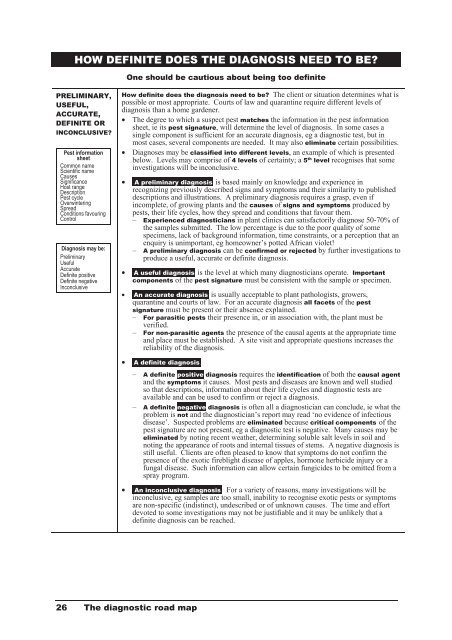PLANT PROTECTION 4
PLANT PROTECTION 4
PLANT PROTECTION 4
Create successful ePaper yourself
Turn your PDF publications into a flip-book with our unique Google optimized e-Paper software.
HOW DEFINITE DOES THE DIAGNOSIS NEED TO BE?<br />
PRELIMINARY,<br />
USEFUL,<br />
ACCURATE,<br />
DEFINITE OR<br />
INCONCLUSIVE?<br />
Pest information<br />
sheet<br />
Common name<br />
Scientific name<br />
Causes<br />
Significance<br />
Host range<br />
Description<br />
Pest cycle<br />
Overwintering<br />
Spread<br />
Conditions favouring<br />
Control<br />
Diagnosis may be:<br />
Preliminary<br />
Useful<br />
Accurate<br />
Definite positive<br />
Definite negative<br />
Inconclusive<br />
One should be cautious about being too definite<br />
How definite does the diagnosis need to be? The client or situation determines what is<br />
possible or most appropriate. Courts of law and quarantine require different levels of<br />
diagnosis than a home gardener.<br />
The degree to which a suspect pest matches the information in the pest information<br />
sheet, ie its pest signature, will determine the level of diagnosis. In some cases a<br />
single component is sufficient for an accurate diagnosis, eg a diagnostic test, but in<br />
most cases, several components are needed. It may also eliminate certain possibilities.<br />
Diagnoses may be classified into different levels, an example of which is presented<br />
below. Levels may comprise of 4 levels of certainty; a 5 th level recognises that some<br />
investigations will be inconclusive.<br />
A preliminary diagnosis is based mainly on knowledge and experience in<br />
recognizing previously described signs and symptoms and their similarity to published<br />
descriptions and illustrations. A preliminary diagnosis requires a grasp, even if<br />
incomplete, of growing plants and the causes of signs and symptoms produced by<br />
pests, their life cycles, how they spread and conditions that favour them.<br />
– Experienced diagnosticians in plant clinics can satisfactorily diagnose 50-70% of<br />
the samples submitted. The low percentage is due to the poor quality of some<br />
specimens, lack of background information, time constraints, or a perception that an<br />
enquiry is unimportant, eg homeowner’s potted African violet!<br />
– A preliminary diagnosis can be confirmed or rejected by further investigations to<br />
produce a useful, accurate or definite diagnosis.<br />
A useful diagnosis is the level at which many diagnosticians operate. Important<br />
components of the pest signature must be consistent with the sample or specimen.<br />
An accurate diagnosis is usually acceptable to plant pathologists, growers,<br />
quarantine and courts of law. For an accurate diagnosis all facets of the pest<br />
signature must be present or their absence explained.<br />
– For parasitic pests their presence in, or in association with, the plant must be<br />
verified.<br />
– For non-parasitic agents the presence of the causal agents at the appropriate time<br />
and place must be established. A site visit and appropriate questions increases the<br />
reliability of the diagnosis.<br />
A definite diagnosis.<br />
26 The diagnostic road map<br />
– A definite positive diagnosis requires the identification of both the causal agent<br />
and the symptoms it causes. Most pests and diseases are known and well studied<br />
so that descriptions, information about their life cycles and diagnostic tests are<br />
available and can be used to confirm or reject a diagnosis.<br />
– A definite negative diagnosis is often all a diagnostician can conclude, ie what the<br />
problem is not and the diagnostician’s report may read ‘no evidence of infectious<br />
disease’. Suspected problems are eliminated because critical components of the<br />
pest signature are not present, eg a diagnostic test is negative. Many causes may be<br />
eliminated by noting recent weather, determining soluble salt levels in soil and<br />
noting the appearance of roots and internal tissues of stems. A negative diagnosis is<br />
still useful. Clients are often pleased to know that symptoms do not confirm the<br />
presence of the exotic fireblight disease of apples, hormone herbicide injury or a<br />
fungal disease. Such information can allow certain fungicides to be omitted from a<br />
spray program.<br />
An inconclusive diagnosis. For a variety of reasons, many investigations will be<br />
inconclusive, eg samples are too small, inability to recognise exotic pests or symptoms<br />
are non-specific (indistinct), undescribed or of unknown causes. The time and effort<br />
devoted to some investigations may not be justifiable and it may be unlikely that a<br />
definite diagnosis can be reached.







![[Compatibility Mode].pdf](https://img.yumpu.com/27318716/1/190x135/compatibility-modepdf.jpg?quality=85)









